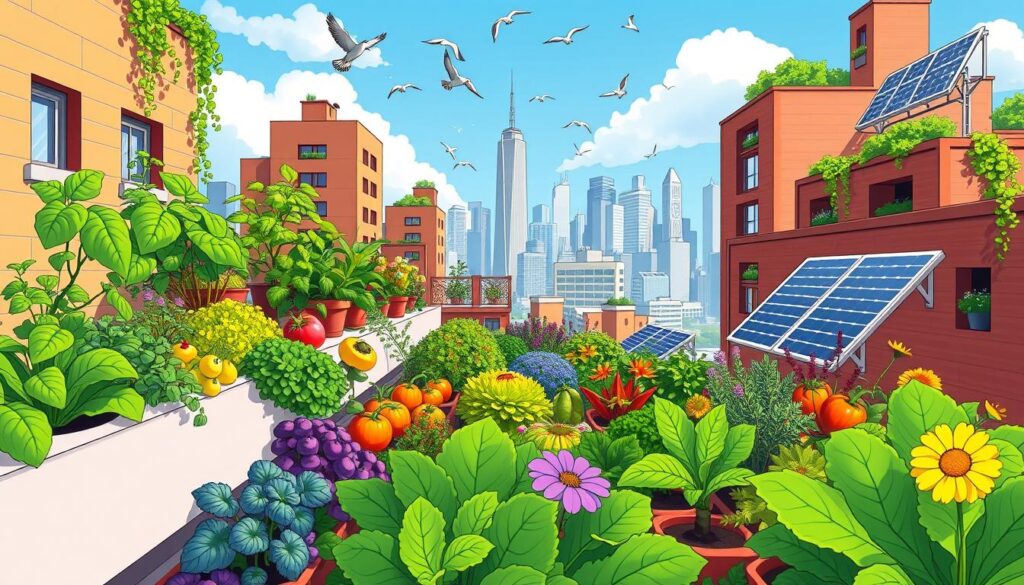More than half of the world’s people live in cities now. By 2050, this number will jump to 68%. This growth has led to a big change in how we grow food in cities. Urban farming is turning cities into green spaces, using new ways to grow food locally.
Companies like Bowery Farming and Green Sense Farms are leading this change. They use high-tech vertical farming to grow food up to 100 times more efficiently than old methods. They use robots, AI, and data to grow food and create jobs, all while being kind to the planet.
Bowery Farming uses 95% less water than traditional farming. This shows how focused they are on being green. Urban farms also help people get better food and bring communities together, especially for those who need it most.
Key Takeaways
- Over half of the global population now lives in cities, with projected growth to 68% by 2050.
- Urban farming companies like Bowery Farming and Green Sense Farms are pioneering high-tech vertical farming systems.
- Vertical farming can yield up to 100 times more produce per square foot compared to traditional methods.
- Urban farming initiatives emphasize environmental sustainability, using up to 95% less water than traditional farming.
- Urban agriculture has been shown to improve nutrition and promote social inclusion in marginalized communities.
The Evolution of Urban Agriculture: From Past to Present
Urban agriculture has a long and interesting history. It goes back to ancient times. In 3,500 B.C., people in Persia used aqueducts to bring water to oases for farming. The Aztecs even had floating islands called “chinampa” for farming outside their cities.
In the late 19th and early 20th centuries, allotment gardens appeared in cities like London and Paris. They helped the poor grow their own food. During World War I and II, “victory gardens” became a big deal. They showed how important city farming impact is in hard times.
In the 1970s, urban agriculture started to focus on social justice and the environment. Community gardens led to today’s urban farming movement. Now, we see everything from rooftop gardens to high-tech vertical farms.
Current State of Urban Farming
Today, urban farming is all about technology, policy support, and being green. It helps make food more secure, boosts local economies, and improves city environments. Organic farming is big in cities because it avoids harmful chemicals.
Urban food gardens are coming back because of many reasons. The recession, food safety, public health, and climate change are all factors. The White House Kitchen Garden and the USDA’s People’s Garden program are helping. They promote healthy eating, community, and caring for the environment.
“Urban agriculture plays a crucial role in understanding the intricate relationship between food, water, waste, and energy in cities as a means of building communities and promoting health.”
Understanding Sustainable Urban Farming Techniques
Cities are getting bigger, and we need more fresh food. Sustainable urban farming is key to meet this need. It uses eco-friendly methods to grow food efficiently and with less harm to the environment.
Vertical farming is a big part of this. It grows crops in layers, making the most of small spaces. This method can produce up to 20 times more food than traditional farming. It uses special lights and systems to help plants grow well.
Hydroponics and aquaponics are also popular in cities. Hydroponics grows plants in water, saving up to 90% of water. Aquaponics adds fish to the mix, creating a complete food system.
Permaculture is another method. It uses nature to create farms that need little help from outside. It focuses on water, soil, and plants working together.
Urban farms are good for the planet and bring people together. They turn empty spaces into places where we can grow our own food. This changes how we think about food in cities.
| Sustainable Urban Farming Technique | Key Benefits |
|---|---|
| Vertical Farming | Increased yields, reduced land and water use, energy-efficient lighting |
| Hydroponics | Up to 90% water savings, no soil required, controlled growing conditions |
| Aquaponics | Sustainable closed-loop system, produces both plants and fish, minimal waste |
| Permaculture | Integrates natural systems, promotes biodiversity, minimizes external inputs |
As cities grow, these farming methods are a bright spot. They help feed people, protect the environment, and bring communities together worldwide.
Vertical Farming: The Future of Urban Food Production
Urban areas are getting more crowded, making it hard to grow food in small spaces. Vertical farming is changing this by growing crops up high in indoor spaces. This method uses every inch of space, making more food in less area.
Advanced Growing Systems
Vertical farms use new tech to grow plants better. They use hydroponics and aeroponics, which don’t need soil and save a lot of water. AI and special lights help these farms work well all day, every day, no matter the weather.
Resource Optimization Methods
Vertical farming is all about using less of everything. It uses smart water systems and closed loops to cut down on waste. Adding solar power makes it even greener. This way, vertical farms are better for the planet and save money on food.
Space-Efficient Design Solutions
Vertical farming is great for small spaces. It can grow a lot of food in a little area. This helps cities grow food without taking up too much land, keeping the countryside green.
With more people coming, we need to grow food better and faster. Vertical farming is key to making cities more food-savvy and eco-friendly. It’s a smart way to feed our growing world.
“Vertical farming empowers communities to take control of their food production, reducing reliance on external sources and promoting self-sufficiency.”
Hydroponic and Aquaponic Systems in City Environments
As cities grow, new farming methods like hydroponic farming and aquaponic systems are becoming key. These soilless agriculture methods are efficient and sustainable. They change how we farm in cities.
Hydroponics grows plants in water, not soil. It can increase yields by 20 times per acre. Aquaponics adds fish farming to hydroponics. Fish waste feeds plants, and plants clean the water for fish.
- Hydroponics and aquaponics grow food all year, not just in seasons. This means fresh produce is always available.
- They use much less water than traditional farming. This makes them good for places with little water.
- These systems need fewer chemicals. This means the food is healthier and free from harmful substances.
Starting these systems can cost a lot. But the long-term benefits are worth it. They help cities grow food, reduce waste, and create a greener future.
“Aquaponics has a water efficiency rate of 90% compared to traditional soil-based agriculture and fish farming.”
The world’s population is expected to hit 9.7 billion by 2050. We need new, efficient farming ways. Hydroponic and aquaponic systems are a good answer. They help cities produce food and build a stronger, self-sufficient future.
Technology Integration in Modern Urban Agriculture
Urban agriculture is changing fast, thanks to new technologies. Agtech, or agricultural technology, is changing how we grow and share food in cities. AI and smart systems help farmers grow more food in less space.
AI and Automation Solutions
Companies like Bowery Farming are leading the way with smart farming. Their BoweryOS uses AI to watch over plants and adjust conditions for the best growth. This lets farmers focus on other important tasks.
Smart Monitoring Systems
Smart systems track many things like temperature and water use. They give farmers real-time data to make better choices. This helps farmers use resources wisely and grow more food.
Data-Driven Farming Practices
AI in agriculture and smart systems help farmers make decisions based on data. They can predict problems and find solutions. This makes farming in cities more reliable and green.
As cities get bigger, we need more local food. Agtech helps farmers meet this need. It’s changing how we grow food in cities for a better future.
Rooftop Gardens and Green Building Integration
Cities are growing, and rooftops are turning into farms. Companies like Brooklyn Grange show how big rooftop farming can be. They grow fresh food, keep buildings cool, and manage stormwater.
Green building integration means adding farms to buildings. This creates spaces that are good for the planet. From parks to farms, these areas help cities be more sustainable.
- Over the past 2 decades, urban constructed ecosystems have expanded to include green roofs, elevated urban parks, and rooftop vegetable farms.
- Drought-tolerant succulents, grasses, and shrubs are grown on built surfaces with little or no supplemental irrigation and nutrients.
- The Brooklyn Grange, a 0.6-hectare rooftop farm, grows vegetables on top of an 11-story building in the former Brooklyn Navy Yard in New York City.
Rooftop gardens and green buildings give cities fresh food. They also make cities more sustainable. As cities grow, these ideas help solve big problems.
| Benefit | Description |
|---|---|
| Building Insulation | Rooftop gardens and green walls can improve energy efficiency by providing insulation and reducing heating and cooling costs. |
| Urban Heat Island Reduction | Increased vegetation and evapotranspiration from green spaces can help mitigate the urban heat island effect, lowering temperatures in dense urban areas. |
| Stormwater Management | Rooftop gardens and green infrastructure can help absorb and filter stormwater, reducing the risk of flooding and improving water quality. |
| Food Production | Rooftop farms and vertical gardens can provide a source of fresh, locally-grown produce, contributing to urban food security and sustainability. |
“Designed approaches include large-scale elevated urban parks and rooftop agriculture. The Brooklyn Grange, a 0.6-hectare rooftop farm, grows vegetables on top of an 11-story building in the former Brooklyn Navy Yard in New York City.”
Community Gardens: Building Social Sustainability
Community gardens are key in making cities better places to live. They bring people together, helping them share knowledge and make friends. These gardens teach people about food and how to live sustainably, helping them make better choices.
These gardens include everyone, especially those who are often left out. They help low-income families and new immigrants keep their food traditions alive. The Johns Hopkins Center for a Livable Future says these gardens are like bridges, connecting people and making cities stronger.
Collaborative Growing Spaces
In community gardens, people work together to grow food and improve their neighborhoods. It’s a way for everyone to feel like they own a piece of their community. By working together, gardeners build a strong network and learn to appreciate the value of urban social sustainability.
Educational Initiatives
Education is a big part of community gardens. They offer workshops and hands-on learning to teach people about food and sustainability. This helps people understand the importance of community gardening and how to live more sustainably.
Community Engagement Programs
Good community gardens include everyone, especially those who are often left out. They help low-income families and new immigrants feel welcome and share their food traditions. This helps build a strong, diverse community through collaborative farming.
“Community gardens serve as ‘social bridges,’ facilitating community bonds and helping preserve cultural traditions associated with food.”
– Johns Hopkins Center for a Livable Future
| Key Highlights | Value |
|---|---|
| Community gardens reduce dependence on long-distance transportation and industrialized agriculture | Enhancing food security and local food production |
| Community gardens act as educational platforms | Promoting sustainable agriculture, nutrition, and food systems |
| Community gardens foster social cohesion and community building | Bringing together individuals from diverse backgrounds |
| Sustainable practices in community gardens | Contributing to environmental sustainability |
Economic Viability and Business Models
The world of urban farm economics is changing fast. New business models are making these farms sustainable and profitable. Companies like Gotham Greens are working with grocery stores to offer fresh, local produce all year. This shows how urban farms can succeed in today’s market.
Urban farms are not just making money; they’re also creating jobs and boosting local economies. A World Bank study found that urban farming helps people earn more. It also helps fight food insecurity and supports community growth.
But, urban farms face big challenges. They must compete with large-scale farms that have lower costs. To win, they’re using new ways to sell, like direct to consumers and creating value-added products. For example, Urban Growers Collective in Chicago uses a CSA program to support racial justice and sell produce.
Urban farming is key to a strong local food economy. With help from institutions, governments, and communities, urban farms can grow. This will lead to a more sustainable, resilient, and fair food system in cities.
“Urban farming has the potential to provide nutrient-rich food for the more than 80% of the U.S. population residing in urban areas while addressing food insecurity, job insecurity, and biodiversity loss.”
The urban farming movement is growing, and focusing on making money and finding new ways to sell is key. By using green practices and working with local communities, urban farms can flourish. They will help make cities better, more just, and prosperous for everyone.
Environmental Impact and Resource Conservation
Urban farming is changing the game for a sustainable future. It uses new ways to save resources, making food production in cities better for the planet.
Water Management Systems
Urban farming cuts down water use a lot. Aquaponics is a method that uses fish waste to feed plants. This cuts water waste by up to 95% compared to old farming ways.
Energy Efficiency Measures
Urban farms use smart energy-saving tech. Vertical farming uses LED lights and climate control to grow more with less energy. Container farming turns old shipping containers into farms with hydroponics or aeroponics, saving even more energy.
Waste Reduction Strategies
Urban farming helps cut down waste too. It grows food close to where people live, saving energy from long food transport. It also uses circular economy principles to turn organic waste into compost, reducing landfill waste.
These green practices make urban farming more resource-efficient and eco-friendly. They help cities live in balance with nature.
Policy and Regulatory Framework
As urban agriculture grows, cities are changing their rules to help. They see the good it can do for communities. This change is key for urban agriculture.
Many cities are updating their zoning laws to make room for urban farming. This is important for solving problems like finding land and dealing with contaminated soil. They also offer tax breaks for urban farms and include urban agriculture in plans to fight climate change.
Creating strong urban agriculture policies is vital. It helps these projects grow and last. Support from policies is crucial for the success of sustainable urban planning.
Regulatory Advancements
- The 2018 Farm Bill helped urban agriculture by setting up a new office and committee. It also gave the USDA the power to give grants for urban farming.
- In 2022, the USDA started a new advisory committee for urban agriculture. This shows the government’s commitment to city farming regulations.
- The Environmental Protection Agency (EPA) has a guide for urban growers. It helps them start farms in tough spots.
- The USDA works with botanical gardens to help with urban agriculture. They offer advice on planning, design, and food safety.
As more people move to cities, we need better urban agriculture policy. It’s up to policymakers and regulators to create a supportive environment. This will help city farming grow and thrive.
Challenges and Solutions in Urban Farming
Urban farming is a promising way to solve food security and sustainability issues. But, it faces many obstacles. These include limited space in cities, technical hurdles in farming systems, and shortages of water and energy.
Space Limitations
One big challenge is finding enough land in crowded cities. Vertical farming and using unused urban areas are new solutions. Vertical farming uses space up and down, not just out.
Technical Barriers
Using advanced farming methods in cities can be tricky. Hydroponics and aquaponics need special knowledge and tools. But, research and development are making these methods more accessible.
Resource Constraints
Urban farming also struggles with water and energy availability. Water recycling systems and renewable energy sources help solve these problems. They make urban farming more sustainable.
Beating urban farming challenges needs teamwork from planners, tech experts, and farmers. With new ideas, support from policies, and community involvement, urban agriculture’s future looks bright. It promises to feed cities and create sustainable communities.
| Challenges | Innovative Solutions |
|---|---|
| Space Limitations | Vertical Farming, Repurposing Underutilized Spaces |
| Technical Barriers | Hydroponics, Aquaponics, Automation |
| Resource Constraints | Water Recycling, Renewable Energy Integration |
“Overcoming the obstacles in urban farming requires a collaborative effort between urban planners, technologists, and farmers. With continued innovation, policy support, and community engagement, the future of urban agriculture holds great promise in feeding cities and building more sustainable communities.”
Conclusion
Urban farming is key to solving many city problems. It helps with food security, economic growth, and keeping the environment clean. It also brings people together in communities.
As cities get bigger, growing food in the city will become more crucial. We see everything from high-tech vertical farms to community gardens. These solutions fit different city needs.
But, there are still hurdles like finding space, dealing with technology, and limited resources. Despite these, the benefits of urban farming are huge. It’s a promising area for more investment and support.
Urban farming can make cities healthier and more connected. It’s about meeting the need for future of urban farming, sustainable city agriculture, and strong urban food systems.
By using new tech, using resources wisely, and getting people involved, urban farming can change cities. It can make them centers of food, care for the environment, and community. This movement is bringing us closer to a better, fairer urban future.







